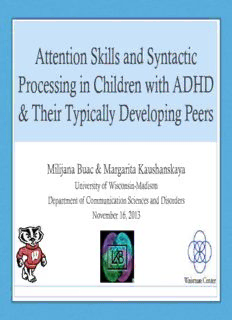
Attention Skills in Syntactic Processing in Children With ADHD & Their Typically Developing Peers PDF
Preview Attention Skills in Syntactic Processing in Children With ADHD & Their Typically Developing Peers
Attention Skills and Syntactic Processing in Children with ADHD & Their Typically Developing Peers Milijana Buac & Margarita Kaushanskaya University of Wisconsin-Madison Department of Communication Sciences and Disorders November 16, 2013 Disclosure Statement • Milijana Buac does not have financial or nonfinancial relationships relevant to the content of the presentation. • Margarita Kaushanskaya does not have financial or nonfinancial relationships relevant to the content of the presentation. ADHD Prevalence • Approximately 3 to 7% of school-age children have ADHD (Diagnostic and Statistical Manual of Mental Disorders) • From 2000 to 2010, school-based SLPs served on average EIGHT students with ADHD in their monthly caseload (ASHA Schools Survey report: Caseload characteristics trends, 1995–2010) What is ADHD? Inattentive Impulsive-Hyperactive Combined Impact of ADHD • Executive Functions Deficits • Difficulties inhibiting (e.g., Geurts, 2004) • Working memory difficulties (e.g., Martinussen et al., 2005) • High comorbidity between language impairment and ADHD has been documented (Redmond, 2005; Cohen, Vallance, Barwick, Im, , suggesting a possible Menna, Horodezky, & Isaacson, 2000) relationship between attention and language. Research Questions • Whether and to what degree ADHD impacts executive function mechanisms in school-age children. • Whether and to what degree ADHD impacts language performance. • Is the impact of ADHD on language performance driven by poor attention or by poor language? Screening Tool • ADHD screener • Conners 3 (Conners, 2009) Participants Measure ADHD High Conners TD n 7 6 7 Age 8.43 (.91) 8.35 (.74) 8.43 (.87) Gender 5 boys 3 boys 5 boys SES1 6.0 (1.16) 6.17 (1.47) 6.00 (1.00) Nonverbal IQ2 98.29 (18.01) 105.57 (18.45) 96.86 (18.48) 1. SES measured using a Likert Scale 1-8; 1-some high school; 8-professional degree 2. Nonverbal IQ measured using the Kaufman Brief Intelligence Test, Matrices Subtest
Description: